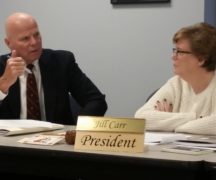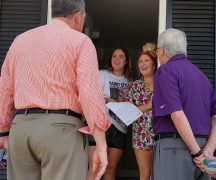By JAN LARSON McLAUGHLIN
BG Independent News
Though it may sound trite, it’s teamwork that makes Bowling Green work, and it’s those teammates who will get it through tough times in the future.
That teamwork was seen in city government last year, with a solar field being built, a park levy being passed, streets being paved, sidewalks being replaced and trees being planted, Mayor Dick Edwards said Thursday during the annual State of the City address.
Vital members of the team are Bowling Green City Schools and Bowling Green State University, which have the ability to bring new residents and businesses to the community.
“There are hundreds of details,” to make a community work, Edwards said during the address hosted by the Bowling Green Chamber of Commerce.
Among the many teammates are the fire division which responded to more than 3,000 calls last year, and the police division that reached out to the community with a new “Coffee with Cops” program.
Both divisions are nationally accredited – which only six cities in Ohio can boast. “This speaks directly to their extremely high level of service,” Edwards said. “It’s a very, very demanding process.”
Last year, economic development in the city brought in investments of more than $47 million in machinery and equipment, and more than $24 million in business construction.
“Bowling Green is on the right track for 2017,” the mayor said, noting that during his annual visits with industries, many have indicated they are likely to add more jobs.
The city’s utilities also continue to be a point of pride – with a state-of-the-art water treatment plant, an electric system that recently was awarded for reliability, and the building of the largest solar field in Ohio. The city’s energy portfolio is now nearly 40 percent renewable power, which is “almost unparalleled,” the mayor said.
“Our utility rates are among the best and most competitive in the region,” Edwards said.
The mayor pointed out the city’s historic commitment to earmarking a portion of its income tax revenue for utilities. “We are a fortunate community to have the level of service” from city utilities, he said.
The city, however, continues to struggle with declining general fund revenue. “We’re been wrestling with this for a decade,” Edwards said.
Cuts from federal and state government have led to annual losses of more than $1.8 million since 2007. The result has been a “much leaner” city government, despite increases in local income tax revenue.
“We have reacted in a responsible and very conscientious manner,” Edwards said.
But the city is now faced with a decision on how to help the general fund recover. Two of the options being considered are privatizing garbage collection or shifting the income tax revenues so more goes into the general fund.
With teamwork, Edwards is confident the city can weather this revenue issue as it has dealt with problems in the past.
“I remain optimistic we will be able to respond in a fair manner,” the mayor said.
The city is also looking toward the completion of the Community Action Plan, progress on the downtown green space, and work on the proposed roundabouts on East Wooster Street at the Interstate 75 interchanges.
“I share with you a real sense of optimism and hope for our city in 2017,” Edwards said.
Those high expectations were echoed by Bowling Green City Council member Bruce Jeffers. In addition to the focus on the general fund revenue recovery, Jeffers listed council’s priorities as beginning implementation of the Community Action Plan, Complete Streets, Oak Grove Cemetery, city charter review, revisiting historic preservation efforts, continuing to diversify employment, beginning East Wooster Street improvements, and working on Wooster Green.
Jeffers talked about the success of the recent Court Street Connects festival – which kicked off the Community Action Plan efforts. He cautioned, however, that the neighborhood improvement process will take time.
“I urge the community to remain patient with the process,” he said.
Jeffers also talked about City Council’s continued commitment to welcoming diversity, with support of the city’s Human Relations Commission and Not In Our Town organization.
“Bowling Green remains a welcoming and inclusive community,” he said. “Regardless of the way political winds may blow.”
Also at the State of the City address, BGSU President Mary Ellen Mazey talked about the university’s role in the community.
“It is all about collaboration and all about a good town-gown relationship,” she said.
Mazey talked about the transformations on campus – both in new educational focuses and in building construction and renovation. The university’s vision statement calls on BGSU to be innovative – which has led to emphasis on forensic science, software engineering and aviation.
The most visible changes to the community are the additions of new buildings, like the Greek housing and Falcon Health Center, and the renovations of buildings like Hanna, University, Moseley and South halls.
Mazey also mentioned the efforts to increase the quality of the freshman class, and the emphasis on student internships and co-ops. “Our students are great in giving back in service to the community.”
Bowling Green City Schools Superintendent Francis Scruci also spoke about the district’s strong role in the city. “It’s a community with a strong sense of pride,” and the schools are a big part of that, he said.
The district leadership believes in meeting the needs of today’s students, he said.
“We understand today’s learner is different. Our students are more connected than ever,” with the digital age, Scruci said. But the ultimate goal remains the same – “development of a child.”
The district also believes in inclusivity, a celebration of diversity, and transparency with the community, Scruci said.
“We believe it is vital,” he said.
All of that makes the school district a piece of the overall puzzle in the city’s development.
“Our role is very important in attracting families,” Scruci said.
The superintendent mentioned some of the latest district successes, including the “One Book BG” project leading 1,500 elementary students and their families to read together. He listed the great arts programs in the district, the increased STEM offerings, and plans to expand travel abroad for students.
Scruci also talked about the installation of “The Boot” safety system on classroom doors throughout the district. Residents and businesses in the community donated more than $40,000 for the safety equipment.
“It’s just another example of our community doing more than talk the talk,” he said.
According to Scruci, the district’s success can also be seen in the number of students progressing to college after they graduate. Of this year’s senior class, 83 percent will be attending four-year colleges, and another 9 percent will be attending two-year colleges.
The superintendent also pointed out challenges facing the district.
“We continue to struggle with the amount of testing our students are subjected to,” he said.
And the district is looking for the best answer to its aging school buildings, he added. Community forums have been held for the past year and a survey was conducted.
“Now the board is faced with making a very tough and courageous decision,” Scruci said.
Challenges are also coming from Washington, D.C., where emphasis is being placed on voucher and charter schools, he said.
“Public education as we know it is under attack,” he said.
“Public schools are not failing,” he continued. “We educate every student who walks through our doors,” regardless of disabilities.
But Scruci remained positive about the schools playing a positive role in Bowling Green. “Together we can make a difference in the entire community.”





